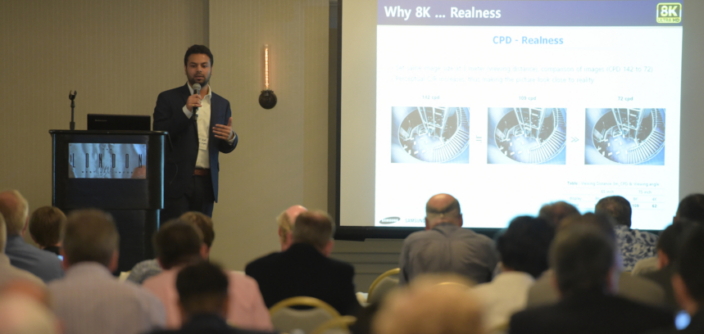How Samsung’s QLED TV Earned video Magazine’s ‘Burn-In’ Certification
on July 11, 2018

Samsung’s QLED TVs recently became the first TVs to be certified burn-in free by video, an acclaimed German tech magazine.
The magazine’s comprehensive evaluation assessed vulnerability to burn-in and afterglow, which can permanently impair picture quality. The results of the test proved that Samsung’s TVs were as free of both, and demonstrated what makes QLED TVs some of the most durable displays on the market today.
The Details
‘Burn-in’ refers to the phenomenon in which static images (such as channel logos, or the health bar in a console game), displayed for an extended period of time, leave a permanent outline on a screen.

Examples of burn-in on conventional TVs
Conducted in conjunction with connect Testlab, a world-renowned testing lab, the 72-hour stress test evaluates a TV’s ability to stand up to the exacting levels of performance that we require in TVs today, focusing specifically on the portrayal of HDR (high-dynamic-range) video.
With some display technologies, memory effects will already keep glowing after one minute of TV use if static picture elements are shown on their screen in high luminosities. In the test, the TVs were therefore made to display a checkerboard pattern for deep black and very bright white values for longer periods of time. The test engineers added variable text elements and an intermittently blinking white frame to the test picture so that the automatic stills detection customary for modern HDR TVs could not spring into action. This helped the testers create similar conditions as in HDR games. In addition to the standard analysis the testers used dark gray images with brightness values of 10 nits– which will show if dark pixels are brightened up. The findings indicate that QLED TVs are unaffected by burn-in and afterglow, and that fixed images may be displayed on them without risk, regardless of duration.
Why Burn-in Matters
Assessing a TV’s susceptibility to burn-in is key to determining how long it will last – and ultimately whether it’s worth your money. Although all screens get dimmer with age, burn-in’s adverse effect on picture quality can significantly shorten a TV’s lifespan.
On average, based on typical use, consumers should expect their TV’s picture quality to remain roughly the same for anywhere from seven to ten years. What’s interesting to note is that the definition of that term – ‘typical use’ – has expanded in recent years with the rise of binge-watching video and the development of exciting ‘smart TV’ functionalities. Now, on a typical day, we may switch on the TV to watch the latest episode of a favorite show, start a gaming session with friends, or manage our home’s IoT appliances.
Speaking of enjoying dynamic content, these days, so many of our favorite shows and games feature HDR support, which means video that’s brighter and more immersive than ordinary content. As time goes by, however, HDR content can wear down a TV – accelerating burn-in and reducing its lifespan.
In addition, as illustrated by innovative functions like Ambient Mode, which allows QLED TVs to display beautiful, aesthetic-enhancing images when switched off, Samsung is constantly exploring ways to help people get more use out of their TV. Each new function results in TVs being utilized for longer periods of time, which makes durability issues like burn-in more important than ever.

How QLED TVs Deliver
The source of QLED TVs’ durability lies in Samsung’s use of inorganic Quantum dots. Unlike display technologies based on organic materials, Quantum dots do not degrade over time. This allows QLED TVs to offer exceptional picture quality that not only lasts much longer than other displays, but is guaranteed to be burn-in free.
The experts at video are not the first to put Samsung’s guarantee to the test. In fact, industry-trusted TV review site Rtings.com recently conducted a stringent series of tests that measured image retention in dozens of TVs from the market’s leading brands. The pivotal portion of the tests, which reflected typical use conditions, placed colorful logos on the TVs for 10 minutes and measured how many minutes, if any, it took for the imprinted images to disappear.
Samsung’s QLED TV passed with flying colors, earning a perfect score for image quality and lack of burn-in. When subjected to the same tests, however, other displays fared far less well – succumbing to burn-in, and in doing so, further confirming QLED TV’s industry-leading durability.

What it means for Samsung
Rtings’ assessment and video’s certifications are products of Samsung’s steadfast commitment to offering consumers the very best in terms of picture quality.
As Doochan Eum, Samsung Electronics’ Vice President of Visual Display Business, explains, “Consumers simply don’t want to put up with a display that’s not built to handle how we use our TVs today. Quantum dots’ longevity and ability to express 100 percent color volume allow QLED TVs to provide a level of picture quality that will remain consistent and captivating for many years to come.”



